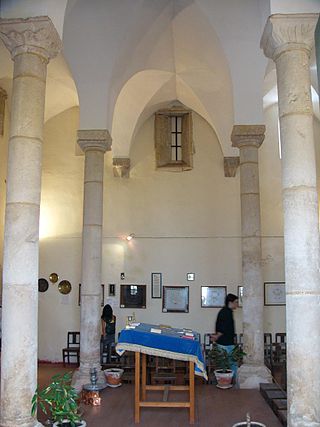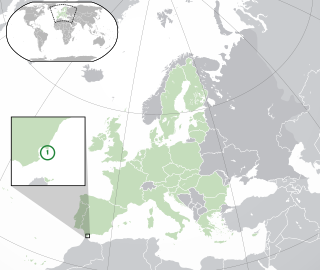
Sephardic or SephardiJews, also Sephardim or PeninsularJews, are a Jewish diaspora population associated with the Iberian Peninsula. The term, which is derived from the Hebrew Sepharad, can also refer to the Mizrahi Jews of Western Asia and North Africa, who were also influenced by Sephardic law and customs. Many Iberian Jewish exiles also later sought refuge in Mizrahi Jewish communities, resulting in integration with those communities.
Christian−Jewish reconciliation refers to the efforts that are being made to improve understanding and acceptance between Christians and Jews. There has been significant progress in reconciliation in recent years, in particular by the Catholic Church, but also by other Christian groups.

The Alhambra Decree was an edict issued on 31 March 1492, by the joint Catholic Monarchs of Spain ordering the expulsion of practising Jews from the Crowns of Castile and Aragon and its territories and possessions by 31 July of that year. The primary purpose was to eliminate the influence of practising Jews on Spain's large formerly-Jewish converso New Christian population, to ensure the latter and their descendants did not revert to Judaism. Over half of Spain's Jews had converted as a result of the religious persecution and pogroms which occurred in 1391. Due to continuing attacks, around 50,000 more had converted by 1415. A further number of those remaining chose to convert to avoid expulsion. As a result of the Alhambra decree and persecution in the years leading up to the expulsion, of Spain's estimated 300,000 Jewish origin population, a total of over 200,000 had converted to Catholicism to remain in Spain, and between 40,000 and 100,000 remained Jewish and suffered expulsion. An unknown number of the expelled eventually succumbed to the pressures of life in exile away from formerly-Jewish relatives and networks back in Spain, and so converted to Catholicism to be allowed to return in the years following expulsion.:17
Spanish and Portuguese Jews, also called Western Sephardim, Iberian Jews, or Peninsular Jews, are a distinctive sub-group of Sephardic Jews who are largely descended from Jews who lived as New Christians in the Iberian Peninsula during the few centuries following the forced expulsion of unconverted Jews from Spain in 1492 and from Portugal in 1497. They should therefore be distinguished both from the descendants of those expelled in 1492 and from the present-day Jewish communities of Spain and Portugal.

The history of the Jews in Turkey covers the 2400 years that Jews have lived in what is now Turkey. There have been Jewish communities in Anatolia since at least the fifth century BCE and many Spanish and Portuguese Jews expelled from Spain by the Alhambra Decree were welcomed into the Ottoman Empire in the late 15th century, including regions now part of Turkey, centuries later, forming the bulk of the Ottoman Jews.

The history of the Jews in Portugal reaches back over two thousand years and is directly related to Sephardi history, a Jewish ethnic division that represents communities that originated in the Iberian Peninsula.

The Sofia Synagogue is the largest synagogue in Southeastern Europe, one of two functioning in Bulgaria and the third-largest in Europe.
Samuel Toledano was a Spanish Jewish community leader and lawyer. As a descendant of an old Jewish family from medieval Toledo, Samuel (Sam) Toledano was a secretary-general and president of Spain's Jewish federation of Israelite communities, later known as the Federation of Jewish Communities of Spain (FCJE) from 1982–1994. For 36 years, he was one of the most prominent Jewish leaders in Spain.

The Synagogue of Tomar is a well-preserved medieval synagogue in Tomar, Portugal. Along with the Synagogue of Castelo de Vide, it is one of two existing pre-expulsion synagogues in the country. It is located at 73 Rua Dr. Joaquim Jaquinto in Tomar's historic city center. Built in the mid-1400s, the building was active as a synagogue only until 1496, when Jews were expelled from Portugal. It now houses the Abraham Zacuto Portuguese Jewish Museum.

Karol Efraim Sidon is a Czech rabbi, writer and playwright. He is the Chief Rabbi of the Czech Republic, and former Chief Rabbi of the city of Prague.

The Old Synagogue in Dubrovnik, Croatia is the oldest Sefardic synagogue still in use today in the world and the second oldest synagogue in Europe. It is said to have been established in 1352, but gained legal status in the city in 1408. Owned by the local Jewish community, the main floor still functions as a place of worship for the High Holy Days and special occasions, but is now mainly a city museum which hosts numerous Jewish ritual items and centuries-old artifacts.

The history of the Jews in Gibraltar dates back more than 650 years. There have been periods of persecution, but for the most part the Jews of Gibraltar have prospered and been one of the largest religious minorities in the city, where they have made contributions to the culture, defence, and Government of Gibraltar.

Solomon Gaon (1912–1994) was Sephardic Rabbi and Hakham of the Spanish and Portuguese Jews of the British Commonwealth.
Congregation Beth Israel Abraham Voliner is an Orthodox Jewish congregation in Overland Park, in the Kansas City Metropolitan Area. Formally established as Tefereth Israel in Kansas City, Missouri in 1894, by 1960 it had moved several times, and merged with three other congregations, taking on its current name. Responding to demographic shifts in Kansas City's Orthodox community, it opened a branch in Overland Park in 1987, and in 1994 it moved to its current location at 9900 Antioch Road.

Congregation Beth Israel is a Modern Orthodox synagogue located in New Orleans, Louisiana. Founded in 1903 or 1904, though tracing its roots back to 1857, it is the oldest Orthodox congregation in the New Orleans region. Originally located on Carondelet Street in New Orleans' Central City, it constructed and moved to a building at 7000 Canal Boulevard in Lakeview, New Orleans, in 1971.

The Kadoorie Mekor Haim Synagogue is a synagogue of the Jewish community of Porto, situated in the civil parish of Lordelo do Ouro e Massarelos, the municipality of Porto, in the Portuguese northern district of Porto. Constructed along the Rua Guerra Junqueiro beginning in 1929 and inaugurated in 1938, it is the largest synagogue in the Iberian Peninsula.
Sephardic Temple Tifereth Israel, also called The Sephardic Temple, is a large, urban Sephardi Jewish synagogue located in Westwood, Los Angeles, California at the corner of Wilshire Boulevard and Warner Avenue. Established on February 1, 1920 as the "Sephardic Community of Los Angeles," it exists today as the merger of three major Sephardic organizations with approximately 600 member families.

The Tiféret Israel Synagogue attack was an attack on Caracas, Venezuela's oldest synagogue that took place on the night of 31 January 2009, during the shabbat. The attack occurred amid a rise in tensions prompted by the 2008–2009 Gaza War, after Venezuela severed diplomatic relations with Israel and Israel responded by expelling Venezuelan officials from the country.
The history of the Jews in Mali dates back to the 8th century CE. Today, around 1,000 descendants of Jews live in Mali, mostly in or near Timbuktu.
Rabbi Yehuda Benasouli was a Morocco-born Orthodox Jewish rabbi in Spain. Benasouli served as the Chief Rabbi of Madrid from 1978 until 2000.















